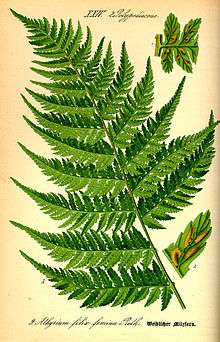Athyriaceae
The Athyriaceae (ladyferns and allies)[2] are a family of terrestrial ferns in the order Polypodiales. In the Pteridophyte Phylogeny Group classification of 2016 (PPG I), the family is placed in the suborder Aspleniineae, and includes two genera.[1] Alternatively, it may be treated as the subfamily Athyrioideae of a very broadly defined family Aspleniaceae.[3] The family has with a cosmopolitan distribution.
| Athyriaceae | |
|---|---|
 | |
| Athyrium filix-femina | |
| Scientific classification | |
| Kingdom: | Plantae |
| Clade: | Tracheophytes |
| Class: | Polypodiopsida |
| Order: | Polypodiales |
| Suborder: | Aspleniineae |
| Family: | Athyriaceae Alston[1] |
| Type genus | |
| Athyrium | |
| Genera | |
|
See text. | |
Description
Species of the Athyriaceae are terrestrial or lithophytic, less commonly aquatic. They grow from various kinds of rhizome: short or long, creeping or erect, branched or not. The distribution and evolution of characters in the family is complex, and the genera have few constant features by which they can be identified. The sporangia have stalks two or three cells wide in the middle, and contain brown monolete spores.[2]
Taxonomy
Earlier classifications
The family was first created by Arthur H.G. Alston in 1956. It has had a varied history. In 2014, Christenhusz and Chase submerged it as the subfamily Athyrioideae within the family Aspleniaceae,[3] a status maintained by Plants of the World Online as of July 2019.[4] The PPG I classification of 2016 restored it to family status.[1]
Athyriaceae is a member of the eupolypods II clade (now the suborder Aspleniineae), in the order Polypodiales.[5] It is related to other families in the clade as in the following cladogram:[6][5]
| Aspleniineae (eupolypods II) |
| ||||||||||||||||||||||||||||||||||||||||||||||||||||||
The Athyriaceae in the past included Cystopteris and Gymnocarpium (now part of Dennstaedtiaceae[1]). The family has been subsumed in the family Woodsiaceae, but a Woodsiaceae defined in this way may be paraphyletic if it omits the Onocleaceae and Blechnaceae (as of 2006, the evidence was not clear).[7]
Genera
As circumscribed in PPG I, Athyriacae contains the following genera.[1]
As of November 2019, the Checklist of Ferns and Lycophytes of the World recognizes three further genera,[8] which other sources include in Athyrium:[1][9]
- Anisocampium C.Presl
- Cornopteris Nakai
- Pseudathyrium Newman
The genera have the following phylogenetic relationship:[10][11]
| Athyriaceae |
| ||||||||||||||||||||||||||||||||||||||||||
Distribution and habitat
Athyriaceae has a worldwide distribution, particularly the genus Athyrium.[12] Most species of Athyriaceae are medium-sized terrestrial ferns, growing in the understorey below trees and shrubs.[2]
References
- PPG I (2016). "A community-derived classification for extant lycophytes and ferns". Journal of Systematics and Evolution. 54 (6): 563–603. doi:10.1111/jse.12229.
- Rothfels, Carl J.; Sundue, Michael A.; Kuo, Li-Yaung; Larsson, Anders; Kato, Masahiro; Schuettpelz, Eric & Pryer, Kathleen M. (2012). "A revised family–level classification for eupolypod II ferns (Polypodiidae: Polypodiales)" (PDF). Taxon. 61 (3): 515–533. doi:10.1002/tax.613003. Archived from the original (PDF) on 2019-07-10. Retrieved 2019-07-30.
- Christenhusz, Maarten J.M. & Chase, Mark W. (2014). "Trends and concepts in fern classification". Annals of Botany. 113 (9): 571–594. doi:10.1093/aob/mct299. PMC 3936591. PMID 24532607.
- "Athyriaceae Alston", Plants of the World Online, Royal Botanic Gardens, Kew, retrieved 2019-07-30
- Rothfels, Carl J.; Larsson, Anders; Kuo, Li-Yaung; Korall, Petra; Chiou, Wen-Liang & Pryer, Kathleen M. (2012). "Overcoming Deep Roots, Fast Rates, and Short Internodes to Resolve the Ancient Rapid Radiation of Eupolypod II Ferns". Systematic Biology. 61 (1): 70. doi:10.1093/sysbio/sys001. PMID 22223449.
- Lehtonen, Samuli (2011). "Towards Resolving the Complete Fern Tree of Life". PLoS ONE. 6 (10): e24851. doi:10.1371/journal.pone.0024851. PMC 3192703. PMID 22022365.
- Smith, Alan R.; Pryer, Kathleen M.; Schuettpelz, Eric; Korall, Petra; Schneider, Harald & Wolf, Paul G. (2006). "A classification for extant ferns" (PDF). Taxon. 55 (3): 705–731. doi:10.2307/25065646. Archived from the original (PDF) on 2008-02-26. Retrieved 2008-02-26.
- Hassler, Michael & Schmitt, Bernd (November 2019). "Athyriaceae". Checklist of Ferns and Lycophytes of the World. 8.11. Retrieved 2019-11-27.
- "Pseudathyrium Newman". Plants of the World Online. Royal Botanic Gardens, Kew. Retrieved 2019-11-27.
- Schuettpelz, Eric & Pryer, Kathleen M. (2007). "Fern phylogeny inferred from 400 leptosporangiate species and three plastid genes" (PDF). Taxon. 56 (4): 1037–1050. doi:10.2307/25065903. Archived from the original (PDF) on 2012-04-30. Retrieved 2012-04-30.
- Liu, Yea-Chen; Chiou, Wen-Liang & Kato, Masahiro (2011), "Molecular phylogeny and taxonomy of the fern genus Anisocampium (Athyriaceae)" (PDF), Taxon, 60 (3): 824–830, doi:10.1002/tax.603014, JSTOR 41317249, retrieved 2019-07-30
- "Athyrium Roth". Plants of the World Online. Royal Botanic Gardens, Kew. Retrieved 2019-07-30.